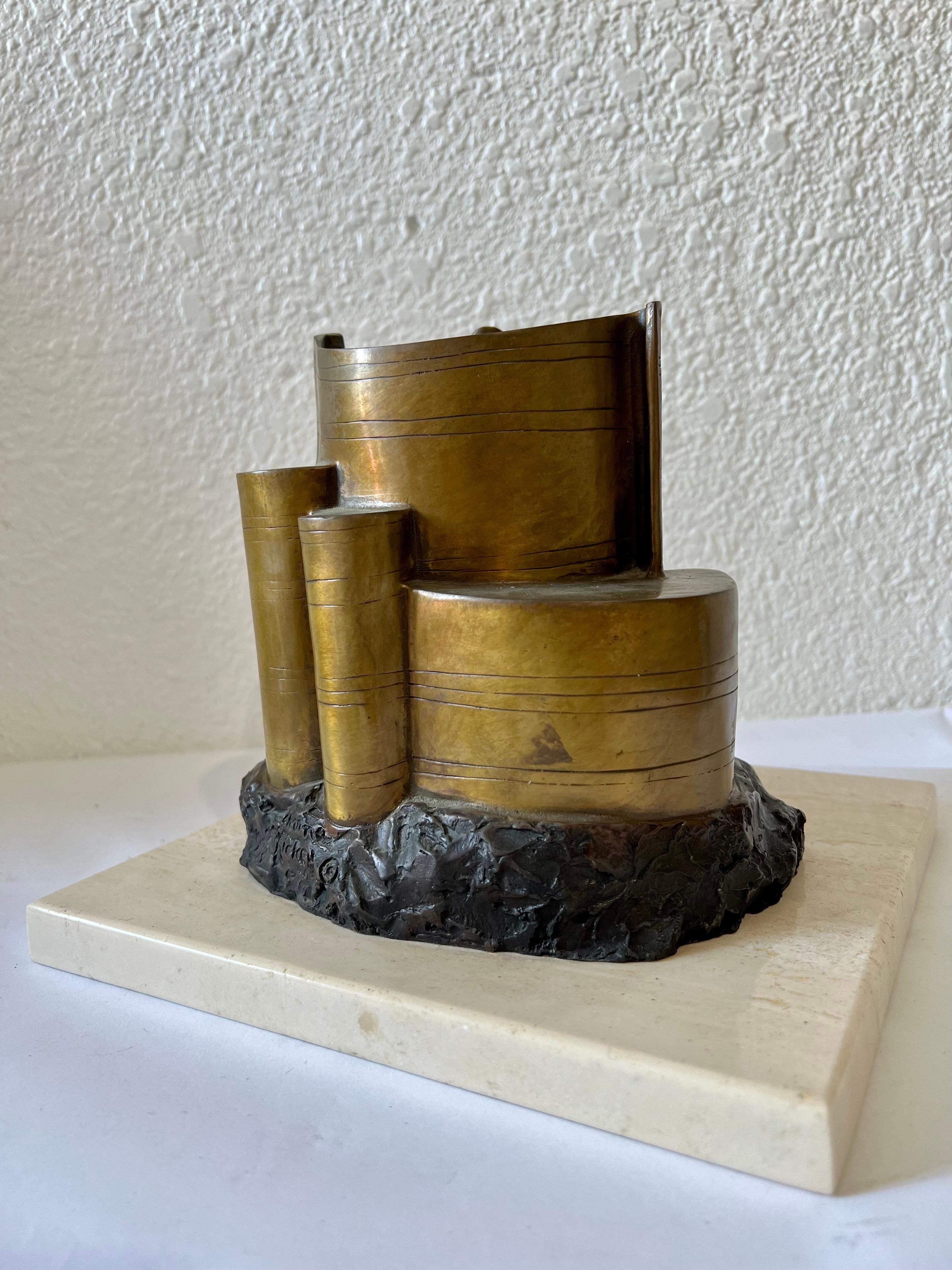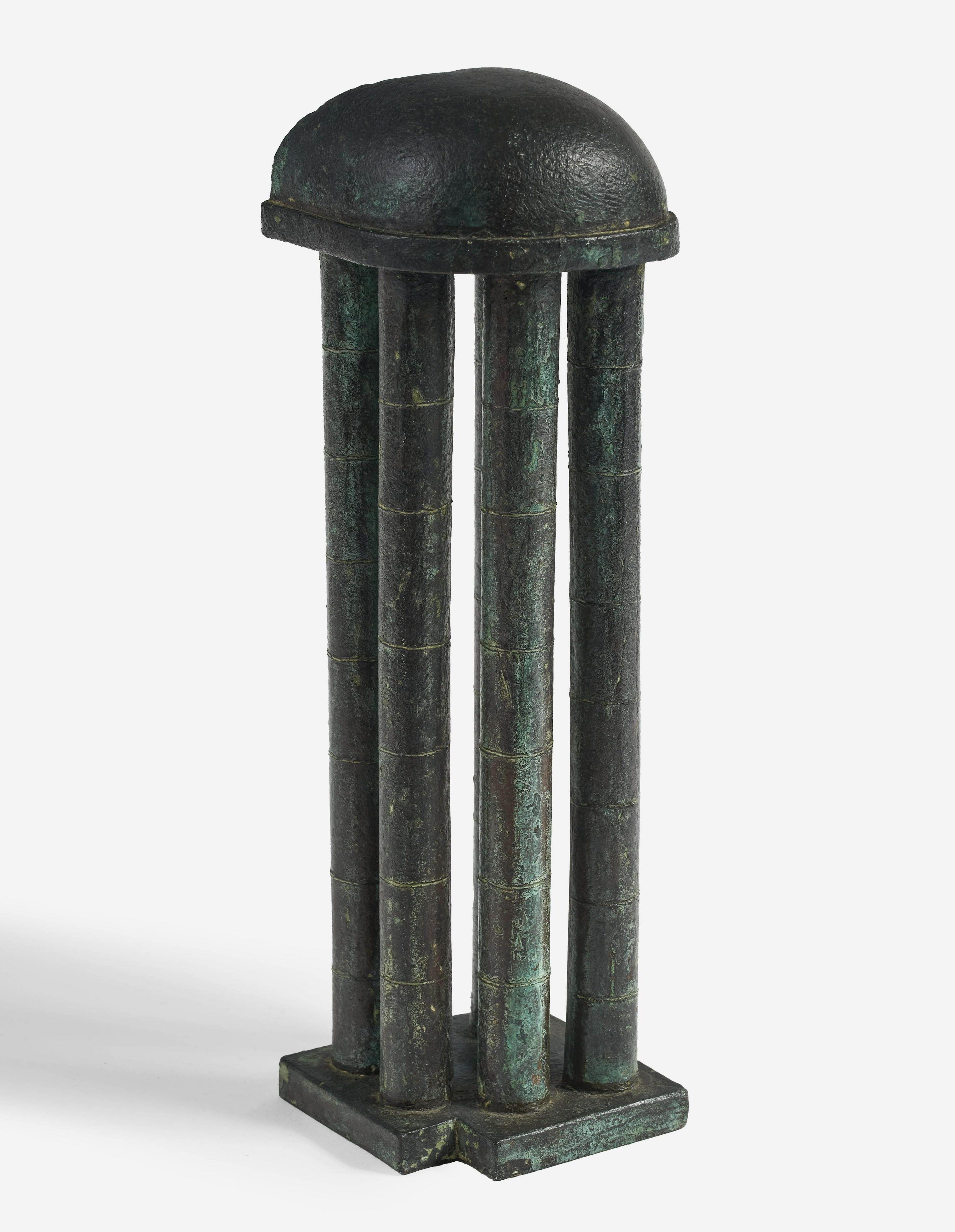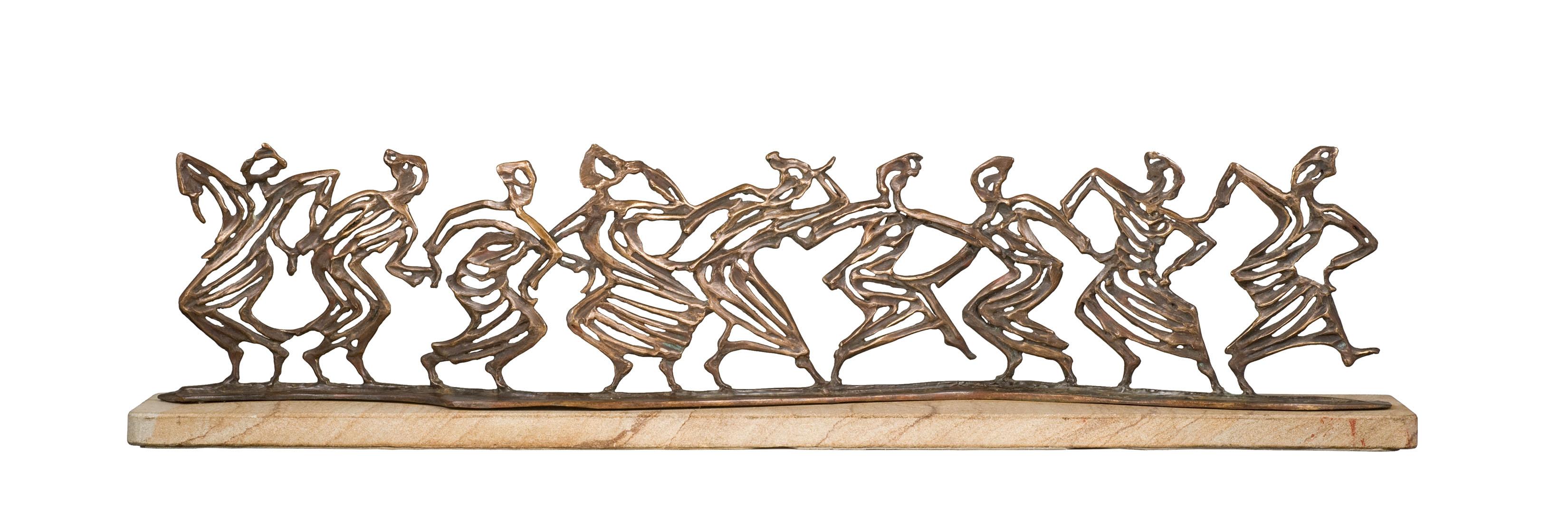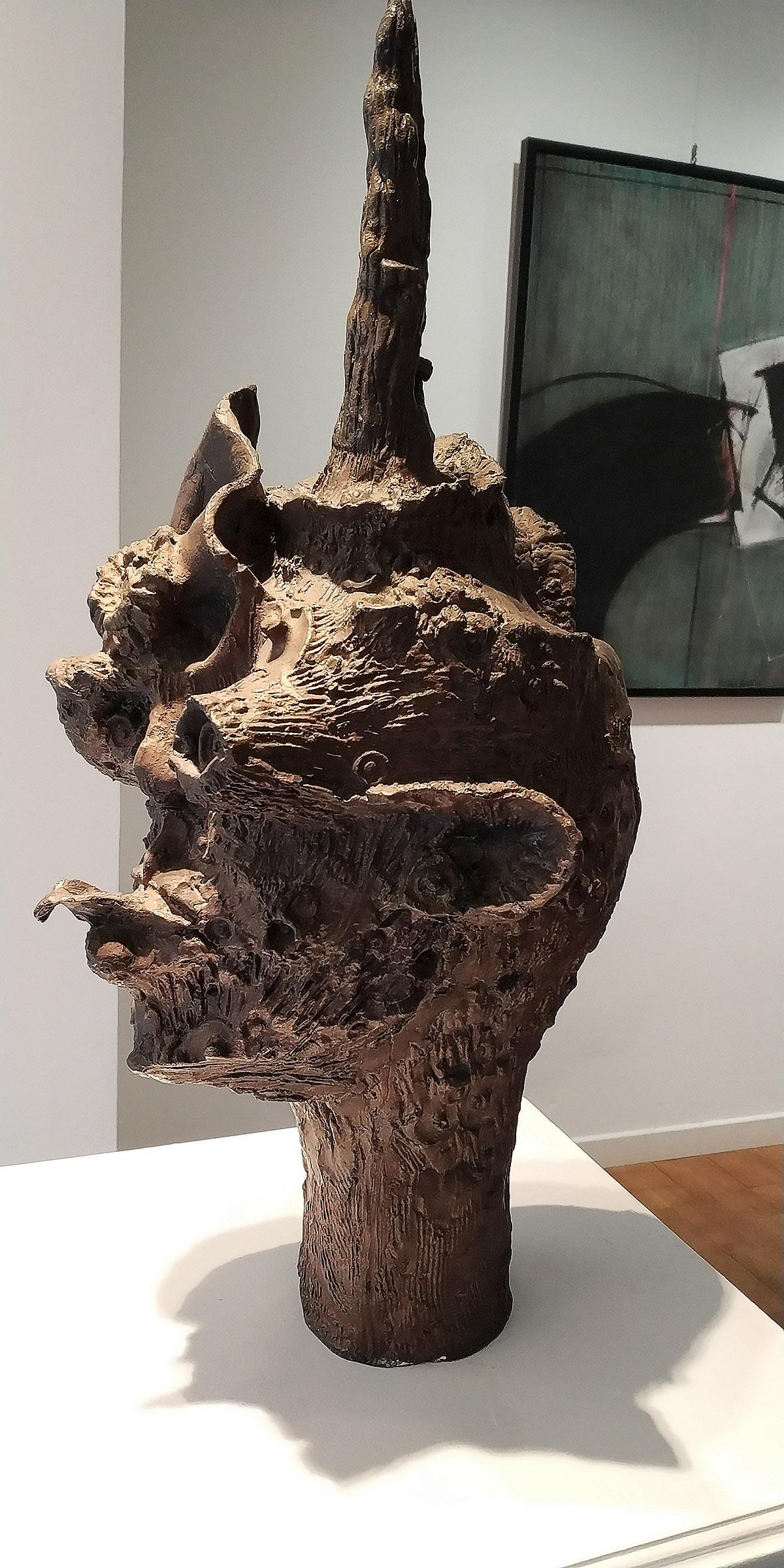Items Similar to Black Falling Man with Form
Want more images or videos?
Request additional images or videos from the seller
1 of 5
Ernest Tino TrovaBlack Falling Man with Form1996
1996
About the Item
Ernest Tino Trova
"Black Falling Man with Form" 1996
Bronze
Ed. 1/3
Signed, Dated and Numbered Verso
approx. 16 x 8.5 x 16 inches
Known for his Falling Man series in abstract figural sculpture, he created hard-edge images that brought him widespread attention because they seem to strike a chord of empathy with viewers who recognized themselves as human beings challenged by a technological society. Also, they are the only creatures aware of their mortality. He is considered highly innovative because of his successful combining of technological methods to create his art.
Interpretation as to overall meanings vary with some thinking that it refers to the fall of man in the religious sense and others seeing it as a commentary on the tragic mechanization of society that reduces human beings. Trova has said that "falling" refers to the fact that man moves from one position to the next in an eventual fall to inevitable oblivion" (Kultermann 11).
He has lived his entire life in St. Louis, Missouri although his reputation is nationwide. He did not think it necessary to study art because he believed in his own instincts, although he drew from a variety of sources including figurative painters such as Francis Bacon, Jean Dubuffet, and Willem DeKooning.
The Falling Man series resulted from a unique offer from the Famous-Barr Department Store in St. Louis, where he had worked as a window decorator in his twenties. Store personnel told him that in exchange for creating a series of works to exhibit at the city's 1964 bicentennial celebration, he could have unlimited access to the store's materials and workers. The store's display department was a great setting for him to be creative with his interest in Pop Art, and this project gave him assembly-line assistance of carpenters, electricians, and painters.
The result was that all images had Falling Man figures, and this included paintings, assemblages, collages, and movable sculpture, both electronic and hand driven. After the Bi-centennial, many of the pieces were then shipped to the Pace Gallery in New York City and received critical acclaim.
Of his technique, he has explained that he first creates a cardboard model and then works from there, often making it life size. He is much more interested in variations of shape and form rather than color.
Ernest Tino Trova died at his home in Richmond Heights, near St. Louis, Missouri on March 8, 2009 at the age of 82. (Obituary.New York Times March 13, 2009.)
- Creator:Ernest Tino Trova (1927 - 2009, American)
- Creation Year:1996
- Dimensions:Height: 16 in (40.64 cm)Width: 16 in (40.64 cm)Depth: 8.5 in (21.59 cm)
- Medium:
- Movement & Style:
- Period:
- Condition:
- Gallery Location:Missouri, MO
- Reference Number:1stDibs: LU74736680712
About the Seller
5.0
Vetted Seller
These experienced sellers undergo a comprehensive evaluation by our team of in-house experts.
Established in 1970
1stDibs seller since 2017
141 sales on 1stDibs
Typical response time: 22 hours
- ShippingRetrieving quote...Ships From: Missouri, MO
- Return PolicyA return for this item may be initiated within 2 days of delivery.
More From This SellerView All
- Estocado, Scenes de CorridaBy Pablo PicassoLocated in Missouri, MOEstocado, Scenes de Corrida, 1959, July 1st Pablo Picasso (Spanish, 1881-1973) Round Dish O.P. white earthenware clay, decoration in engobes under partial brushed glaze, beige patina...Category
1950s Abstract Abstract Sculptures
MaterialsCeramic
- Fish PitcherBy Pablo PicassoLocated in Missouri, MOFish Pitcher 1952 Turned Pitcher 13 cm x 21 cm/approx 8 1/4 x 4 3/4 inches Red Earthenware Clay, Decoration in Engobes Black, White Edition Madoura Picas...Category
1950s Abstract Figurative Sculptures
MaterialsCeramic
- Car Man, Four WheelsBy Ernest Tino TrovaLocated in Missouri, MOErnest Tino Trova "Car Man, Four Wheels" 17 x 8 x 14.5 inches Inscribed T-06 Bottom Known for his Falling Man series in abstract figural sculpture, he created hard-edge images that ...Category
Late 20th Century American Modern Figurative Sculptures
MaterialsBronze
- Falling Man and FormBy Ernest Tino TrovaLocated in Missouri, MOErnest Tino Trova "Falling Man and Form" 1996 Brass and Bronze 14 x 4.5 x 4.5 inches Signed and Numbered 1/1 (Unique) Known for his Falling Man series in...Category
1990s American Modern Figurative Sculptures
MaterialsBronze, Brass
- PeaceBy Heloise CristaLocated in Missouri, MOHeloise Crista (1926-2018) Peace Brass and Copper approx. 15 x 17 x 10 inches Heloise Crista, Acclaimed Sculptor and Frank Lloyd Wright Apprentice FRANK LLOYD WRIGHT FOUNDATION JU...Category
Mid-20th Century American Modern Abstract Sculptures
MaterialsBrass, Copper
- The EncounterBy Ernest TrovaLocated in Missouri, MOErnest Trova "The Encounter" 1994 Chrome Plated Steel Approx 24 x 26 x 24 inches Edition 1/8 Known for his Falling Man series in abstract figural sculpture, he created hard-edge ima...Category
1990s American Modern Figurative Sculptures
MaterialsStainless Steel
You May Also Like
- Bronze Abstract Space Age Book Sculpture LA California Modernist Charna RickeyBy Charna RickeyLocated in Surfside, FLCharna Rickey 1923 - 2000 Mexican-American Jewish Woman artist. Signed Bronze House of Books, Architecture Bronze sculpture, signed Charna Rickey and on the front "House of the book." It depicts an open Torah. Original patina. Approx. dimensions: 7 in. H x 9 in. W x 8.5 in. D. Weight: 13.1 lbs. Modernist Judaica Sculpture Born Charna Barsky (Charna Ysabel or Isabel Rickey Barsky) in Chihuahua, Mexico, the future artist lived in Hermosillo and immigrated to Los Angeles when she was 11. She was educated at UCLA and Cal State L.A., she married furniture retailer David Rickey and explored art while raising their three daughters. Moving through phases in terra cotta, bronze, marble and aluminum, she found success later in life. Rickey became one of the original art teachers at Everywoman's Village, a pioneering learning center for women established by three housewives in Van Nuys in 1963. She also taught sculpture at the University of Judaism from 1965 to 1981. As Rickey became more successful, her sculptures were exhibited in such venues as Artspace Gallery in Woodland Hills and the Courtyard of Century Plaza Towers as part of a 1989 Sculpture Walk produced by the Los Angeles Arts Council. Her sculptures have also found their way into the private collections of such celebrities as Sharon Stone. Another of Rickey's international creations originally stood at Santa Monica College. In 1985, her 12-foot-high musical sculpture shaped like the Hebrew letter "shin" was moved to the Rubin Academy of Music and Dance at Hebrew University in Jerusalem. The free standing architectural Judaic aluminum work has strings that vibrate in the wind to produce sounds. Rickey also created art pieces for the city of Brea. They commissioned some amazing art pieces by Laddie John Dill, Walter Dusenbery, Woods Davy, Rod Kagan, Pol Bury, Niki de Saint Phalle, Magdalena Abakanowicz, Larry Bell, John Okulick...Category
20th Century American Modern Abstract Sculptures
MaterialsMarble, Bronze
- Bronze Architectural Model Sculpture Tempio Bretton Architecture MaquetteLocated in Surfside, FLTEMPIO BRETTON: from the catalogue MONUMENTA, 19th International Sculpture Biennale, Antwerp, Belgium. Tempio Bretton was created in homage to the celebrated English landscapist Capability Brown for the occasion of an exhibition at Bretton Hall in the Yorkshire Sculpture Park , a park in the style of the great master of English garden design. The inclusion in the English garden of a temple ruin, or "eye-catcher," (architectural folly) was used to draw the eye and mind to a focus in time and space, present the beholder with an immediate relationship to an historic past made new within his or her own surroundings, and create a depth of space never before seen in garden design. I took the idea of the temple ruin eye-catcher and reduced it to a scale at the point where architecture and sculpture merged. Tempio Bretton is not capacious enough to walk into, yet it is considerably larger than a man. One view of it presents a knot of golden columns clustered together, topped by a dome shape. The only clue from this side to the temple's non-conformity to historic principle is a sharp notch cut into the square base. Viewed from the opposite side, the cluster of columns capped by an angular top opens up as if to welcome someone in, yet the mysterious core is still impenetrable. These contradictions articulate a confrontation between past and present, and an exciting truth. The past is always at the heart of our constructions in the present. Walter Dusenbery...Category
20th Century American Modern Abstract Sculptures
MaterialsBronze
- Virasat Curved, figurative bronze mantle pieceBy Robert CookLocated in Greenwich, CTA remarkable and unique format bronze of unique cast that could be great for a mantle or console table. In Robert Cook's book entitled “Waxing and Waning” he discusses three castings...Category
Early 2000s American Modern Abstract Sculptures
MaterialsStone, Bronze
- The Test, Assembled Kinetic Modernist Sculpture Puzzle ConstructionBy William King (b.1925)Located in Surfside, FL"The Test," 1970 Aluminum sculpture in 5 parts. Artist's cipher and AP stamped into male figure, front, 20 5/16" x 12 1/2" x 6 5/7" (approx.) American sculptor King is most noted for his long-limbed figurative public art sculptures depicting people engaged in everyday activities such as reading or conversing. He created his busts and figures in a variety of materials, including clay, wood, metal, and textiles. William Dickey King was born in Jacksonville, Florida. As a boy, William made model airplanes and helped his father and older brother build furniture and boats. He came to New York, where he attended the Cooper Union and began selling his early sculptures even before he graduated. He later studied with the sculptor Milton Hebald and traveled to Italy on a Fulbright grant. Mr. King worked in clay, wood, bronze, vinyl, burlap and aluminum. He worked both big and small, from busts and toylike figures to large public art pieces depicting familiar human poses — a seated, cross-legged man reading; a Western couple (he in a cowboy hat, she in a long dress) holding hands; a tall man reaching down to tug along a recalcitrant little boy; a crowd of robotic-looking men walking in lock step. Mr. King’s work often reflected the times, taking on fashions and occasional politics. In the 1960s and 1970s, his work featuring African-American figures (including the activist Angela Davis, with hands cuffed behind her back) evoked his interest in civil rights. But for all its variation, what unified his work was a wry observer’s arched eyebrow, the pointed humor and witty rue of a fatalist. His figurative sculptures, often with long, spidery legs and an outlandishly skewed ratio of torso to appendages, use gestures and posture to suggest attitude and illustrate his own amusement with the unwieldiness of human physical equipment. His subjects included tennis players and gymnasts, dancers and musicians, and he managed to show appreciation of their physical gifts and comic delight at their contortions and costumery. His suit-wearing businessmen often appeared haughty or pompous; his other men could seem timid or perplexed or awkward. Oddly, or perhaps tellingly, he tended to depict women more reverentially, though in his portrayals of couples the fragility and tender comedy inherent in couplehood settled equally on both partners. His first solo exhibit took place in 1954 at the Alan Gallery in New York City. King was elected to the American Academy of Arts and Letters in 2003, and in 2007 the International Sculpture Center honored him with the Lifetime Achievement in Contemporary Sculpture Award. Mr. King’s work is in the collections of the Metropolitan Museum of Art, Guggenheim Museum, Whitney Museum and the Museum of Modern Art in New York and the Hirshorn Museum at the Smithsonian American Art Museum in Washington, among other places, and he had dozens of solo gallery shows in New York and elsewhere. Reviews of his exhibitions frequently began with the caveat that even though the work was funny, it was also serious, displaying superior technical skills, imaginative vision and the bolstering weight of a range of influences, from the ancient Etruscans to American folk art to 20th-century artists including Giacometti, Calder and Elie Nadelman. The New York Times critic Holland Cotter once described Mr. King’s sculpture as “comical-tragical-maniacal,” and “like Giacomettis conceived by John Cheever.”Category
1970s American Modern Figurative Sculptures
MaterialsMetal
- Helen Shirk Sculpture Hand Crafted Studio Vessel, Copper Patina, Colored PencilsLocated in Surfside, FLTitle: Red Pod, CV110V, San Diego, 1997 Fabricated, hammered copper, colored pencils, patina. This is not signed. It bears a label on the interior and the artist has kindly confirmed the attribution to me. Helen Shirk...Category
1990s American Modern Abstract Sculptures
MaterialsCopper
- Unicorn - bronze sculpture - Salvador Aulestia (1915-1994)Located in Milano, MI"TERAPHIM" Salvador Aulestia's Teraphim exhibition and simultaneous video presentation of the Teraphim exhibition held in front of Leonardo da Vinci's "Last Supper" on Corso Magenta...Category
1970s Modern Figurative Sculptures
MaterialsBronze
Recently Viewed
View AllMore Ways To Browse
Fall 1999
Worker Bronze
Bi Sculptures
Francis Bronze
Vintage St Francis
St Francis Sculpture
St Francis Bronze
Concrete Statues 4
Bearbrick Kaws Dissected
Bearbrick Keith Haring 1000
Banksy Police
Kaws Blue Brown
Hermes India Collection
Robert G Lloyd
Bronze Kevin Stone
Andy Warhol Candy Box
Bearbrick Van Gogh
Frey Clay





